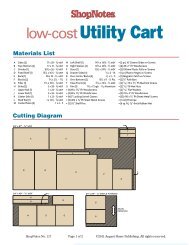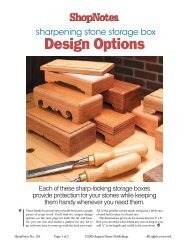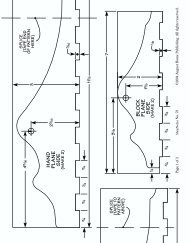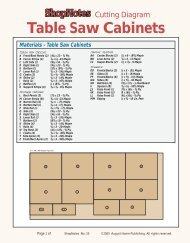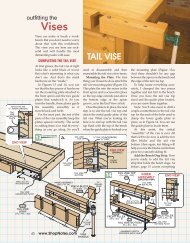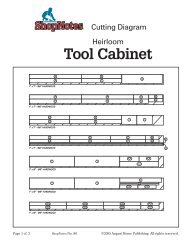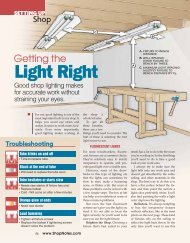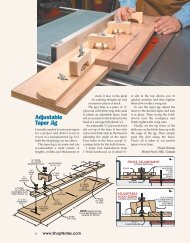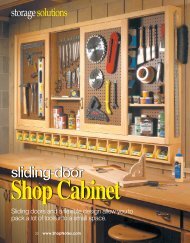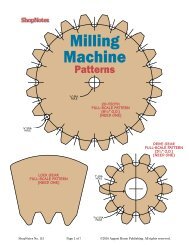Easy-to-use Toggle Clamps - ShopNotes
Easy-to-use Toggle Clamps - ShopNotes
Easy-to-use Toggle Clamps - ShopNotes
Create successful ePaper yourself
Turn your PDF publications into a flip-book with our unique Google optimized e-Paper software.
JIGS &Accessorieseasy-<strong>to</strong>-<strong>use</strong><strong>Toggle</strong><strong>Clamps</strong>Reach for these clamps forthe ultimate in versatility andsafety in your shop.Part of the enjoyment I get out ofwoodworking is finding ways <strong>to</strong>work smarter and safer. So if I findmyself needing an extra pair ofhands, I’ll often turn <strong>to</strong> <strong>to</strong>ggleclamps. They help me concentrateon the job at hand.<strong>Toggle</strong> clamps make your worksafer by keeping parts in placewithout slipping. You get bettercontrol of the workpiece, especiallysmall or hard-<strong>to</strong>-hold parts.Their <strong>use</strong>s in the shop areunlimited. For example, I <strong>use</strong> themHOLD-DOWNCLAMPSOFTRUBBER CAPSPROTECT THE WORKPIECE12 www.<strong>ShopNotes</strong>.com<strong>to</strong> make clamping jigs for gluingup projects. And they make excellenthold-down fixtures forrouting, drilling, or sawing.I also like <strong>to</strong>ggle clamps beca<strong>use</strong>they’re easy <strong>to</strong> <strong>use</strong>. With just a quickflip, I can snap the handle in<strong>to</strong> theclamping position. Releasing themis just as easy. All it takes is a gentletug on the handle with a couple offingers. They really do “<strong>to</strong>ggle” theclamping pressure on or off.When you first look at theseclamps, it’s hard <strong>to</strong> understanda.b.how they work. But after experimentingwith them, you see whatmakes them so powerful.It’s really physics at work. Thehandle acts as a lever that transfersall the force you apply in<strong>to</strong> a singlepoint and then locks it down. It’san ingenious design. It doesn’t takemuch effort <strong>to</strong> put a lot of clampingpressure on your workpiece.Two types of <strong>to</strong>ggle clamps that Ifind most <strong>use</strong>ful are the hold-downand straight-line types.HOLD-DOWN CLAMPSHold-down clamps apply clampingpressure vertically. They’regreat for making a ripping jig(main pho<strong>to</strong> above) or miter sledfor your table saw. They also comein handy at the drill press. You can<strong>use</strong> them <strong>to</strong> hold small parts inposition so your fingers don’t have<strong>to</strong> be close <strong>to</strong> a spinning drill bit, asshown in the inset pho<strong>to</strong> above.Adjustability. What I like mostabout these clamps is how easythey are <strong>to</strong> adjust. With the holddownstyle of clamp, you canadjust the spindle both verticallyand horizontally. Simply adjust theheight of the threaded spindle byloosening the <strong>to</strong>p and bot<strong>to</strong>m nutsand turning the spindle <strong>to</strong> change
the height. Detail ’a’ on the oppositepage shows how it works. Thiscontrols the amount of pressureapplied when you push the leverdown <strong>to</strong> the clamping position. Italso lets you adjust for differentworkpiece thicknesses.You’ll also notice that the holddownarm is slotted <strong>to</strong> accommodatehorizontal movement of thespindle. This allows you <strong>to</strong> slidethe spindle along the arm <strong>to</strong> finetunewhere the pressure is applied.Detail ’b’ on the opposite pageshows this adjustment.STRAIGHT-LINE CLAMPSStraight-line clamps are a little differentthan hold-down clamps.They work by applying pressurehorizontally. This makes themideal for <strong>use</strong> in jigs for gluing upprojects, as in the main pho<strong>to</strong>above. I’ll also <strong>use</strong> a straight-lineclamp on my drill press <strong>to</strong> hold aworkpiece against a fence, like yo<strong>use</strong>e in the inset pho<strong>to</strong> at right.On a straight-line clamp, theplunger moves in or out horizontally,similar <strong>to</strong> a pis<strong>to</strong>n. Thisdesign only allows horizontaladjustment for the spindle. Youloosen the jam nut and turn thethreaded spindle in or out <strong>to</strong>change the clamping pressure(drawing below).STRAIGHT-LINECLAMPa.CUSTOMIZED PRESSUREWith both types of <strong>to</strong>ggle clamps,you can cus<strong>to</strong>mize the amount andtype of pressure you apply. Theycome with rubber caps, as shownin the drawings. But you can alsoorder other types of caps.For more versatility, you canreplace the spindle with a standardhex bolt, as illustrated in the mainpho<strong>to</strong> above. This lets you applymore pressure in a concentratedarea than you might get using justthe soft rubber caps.Other Choices. One of thedownsides <strong>to</strong> the metal <strong>to</strong>ggleclamps shown here is that they canbe a little pricey. I’ve found thatplastic versionscost less andwork very well.And beca<strong>use</strong>they’re plastic,they aren’t aslikely <strong>to</strong> harmyour <strong>to</strong>ols if they happen <strong>to</strong> encountera sharp cutting edge. You can readmore about these in the box below. Forsources for the metal and plastic<strong>to</strong>ggle clamps, see page 51.Once you start using <strong>to</strong>ggle clamps,you’ll find all sorts of handy <strong>use</strong>s forthem in your workshop. They makeyour time spent in the shop a lot moreproductive with better results — andthey’re a whole lot safer.Plastic<strong>Toggle</strong><strong>Clamps</strong>Economical Alternatives.Plastic <strong>to</strong>ggle clampsare suprisingly strong.For occasional clampingneeds, or if you’re justwanting <strong>to</strong> give <strong>to</strong>ggleclamps a try in yourshop, these are goodchoices.www.<strong>ShopNotes</strong>.com 13



